+ データを開く
データを開く
- 基本情報
基本情報
| 登録情報 | データベース: PDB / ID: 7y8a | ||||||
|---|---|---|---|---|---|---|---|
| タイトル | Cryo-EM structure of cryptophyte photosystem I | ||||||
 要素 要素 |
| ||||||
 キーワード キーワード | PHOTOSYNTHESIS / Cryptophyte / Photosystem I / evolution | ||||||
| 機能・相同性 |  機能・相同性情報 機能・相同性情報plastid thylakoid membrane / thylakoid membrane / photosystem I reaction center / photosystem I / photosynthetic electron transport in photosystem I / photosystem I / plastid / chlorophyll binding / chloroplast thylakoid membrane / photosynthesis ...plastid thylakoid membrane / thylakoid membrane / photosystem I reaction center / photosystem I / photosynthetic electron transport in photosystem I / photosystem I / plastid / chlorophyll binding / chloroplast thylakoid membrane / photosynthesis / 4 iron, 4 sulfur cluster binding / oxidoreductase activity / electron transfer activity / magnesium ion binding / metal ion binding 類似検索 - 分子機能 | ||||||
| 生物種 |  Chroomonas placoidea (真核生物) Chroomonas placoidea (真核生物) | ||||||
| 手法 | 電子顕微鏡法 / 単粒子再構成法 / クライオ電子顕微鏡法 / 解像度: 2.71 Å | ||||||
 データ登録者 データ登録者 | Zhao, L.S. / Zhang, Y.Z. / Liu, L.N. / Li, K. | ||||||
| 資金援助 |  中国, 1件 中国, 1件
| ||||||
 引用 引用 |  ジャーナル: Plant Cell / 年: 2023 ジャーナル: Plant Cell / 年: 2023タイトル: Structural basis and evolution of the photosystem I-light-harvesting supercomplex of cryptophyte algae. 著者: Long-Sheng Zhao / Peng Wang / Kang Li / Quan-Bao Zhang / Fei-Yu He / Chun-Yang Li / Hai-Nan Su / Xiu-Lan Chen / Lu-Ning Liu / Yu-Zhong Zhang /   要旨: Cryptophyte plastids originated from a red algal ancestor through secondary endosymbiosis. Cryptophyte photosystem I (PSI) associates with transmembrane alloxanthin-chlorophyll a/c proteins (ACPIs) ...Cryptophyte plastids originated from a red algal ancestor through secondary endosymbiosis. Cryptophyte photosystem I (PSI) associates with transmembrane alloxanthin-chlorophyll a/c proteins (ACPIs) as light-harvesting complexes (LHCs). Here, we report the structure of the photosynthetic PSI-ACPI supercomplex from the cryptophyte Chroomonas placoidea at 2.7-Å resolution obtained by crygenic electron microscopy. Cryptophyte PSI-ACPI represents a unique PSI-LHCI intermediate in the evolution from red algal to diatom PSI-LHCI. The PSI-ACPI supercomplex is composed of a monomeric PSI core containing 14 subunits, 12 of which originated in red algae, 1 diatom PsaR homolog, and an additional peptide. The PSI core is surrounded by 14 ACPI subunits that form 2 antenna layers: an inner layer with 11 ACPIs surrounding the PSI core and an outer layer containing 3 ACPIs. A pigment-binding subunit that is not present in any other previously characterized PSI-LHCI complexes, ACPI-S, mediates the association and energy transfer between the outer and inner ACPIs. The extensive pigment network of PSI-ACPI ensures efficient light harvesting, energy transfer, and dissipation. Overall, the PSI-LHCI structure identified in this study provides a framework for delineating the mechanisms of energy transfer in cryptophyte PSI-LHCI and for understanding the evolution of photosynthesis in the red lineage, which occurred via secondary endosymbiosis. | ||||||
| 履歴 |
|
- 構造の表示
構造の表示
| 構造ビューア | 分子:  Molmil Molmil Jmol/JSmol Jmol/JSmol |
|---|
- ダウンロードとリンク
ダウンロードとリンク
- ダウンロード
ダウンロード
| PDBx/mmCIF形式 |  7y8a.cif.gz 7y8a.cif.gz | 1.3 MB | 表示 |  PDBx/mmCIF形式 PDBx/mmCIF形式 |
|---|---|---|---|---|
| PDB形式 |  pdb7y8a.ent.gz pdb7y8a.ent.gz | 1.2 MB | 表示 |  PDB形式 PDB形式 |
| PDBx/mmJSON形式 |  7y8a.json.gz 7y8a.json.gz | ツリー表示 |  PDBx/mmJSON形式 PDBx/mmJSON形式 | |
| その他 |  その他のダウンロード その他のダウンロード |
-検証レポート
| 文書・要旨 |  7y8a_validation.pdf.gz 7y8a_validation.pdf.gz | 17.5 MB | 表示 |  wwPDB検証レポート wwPDB検証レポート |
|---|---|---|---|---|
| 文書・詳細版 |  7y8a_full_validation.pdf.gz 7y8a_full_validation.pdf.gz | 18.2 MB | 表示 | |
| XML形式データ |  7y8a_validation.xml.gz 7y8a_validation.xml.gz | 230 KB | 表示 | |
| CIF形式データ |  7y8a_validation.cif.gz 7y8a_validation.cif.gz | 285.6 KB | 表示 | |
| アーカイブディレクトリ |  https://data.pdbj.org/pub/pdb/validation_reports/y8/7y8a https://data.pdbj.org/pub/pdb/validation_reports/y8/7y8a ftp://data.pdbj.org/pub/pdb/validation_reports/y8/7y8a ftp://data.pdbj.org/pub/pdb/validation_reports/y8/7y8a | HTTPS FTP |
-関連構造データ
| 関連構造データ |  33683MC 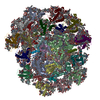 7y7bC M: このデータのモデリングに利用したマップデータ C: 同じ文献を引用 ( |
|---|---|
| 類似構造データ | 類似検索 - 機能・相同性  F&H 検索 F&H 検索 |
- リンク
リンク
- 集合体
集合体
| 登録構造単位 | 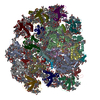
|
|---|---|
| 1 |
|
- 要素
要素
-タンパク質 , 16種, 16分子 123456789CORXZab
| #1: タンパク質 | 分子量: 23479.367 Da / 分子数: 1 / 由来タイプ: 天然 / 由来: (天然)  Chroomonas placoidea (真核生物) Chroomonas placoidea (真核生物) |
|---|---|
| #2: タンパク質 | 分子量: 23400.123 Da / 分子数: 1 / 由来タイプ: 天然 / 由来: (天然)  Chroomonas placoidea (真核生物) Chroomonas placoidea (真核生物) |
| #3: タンパク質 | 分子量: 24966.262 Da / 分子数: 1 / 由来タイプ: 天然 / 由来: (天然)  Chroomonas placoidea (真核生物) Chroomonas placoidea (真核生物) |
| #4: タンパク質 | 分子量: 23548.246 Da / 分子数: 1 / 由来タイプ: 天然 / 由来: (天然)  Chroomonas placoidea (真核生物) Chroomonas placoidea (真核生物) |
| #5: タンパク質 | 分子量: 24055.031 Da / 分子数: 1 / 由来タイプ: 天然 / 由来: (天然)  Chroomonas placoidea (真核生物) Chroomonas placoidea (真核生物) |
| #6: タンパク質 | 分子量: 22688.564 Da / 分子数: 1 / 由来タイプ: 天然 / 由来: (天然)  Chroomonas placoidea (真核生物) Chroomonas placoidea (真核生物) |
| #7: タンパク質 | 分子量: 24550.402 Da / 分子数: 1 / 由来タイプ: 天然 / 由来: (天然)  Chroomonas placoidea (真核生物) Chroomonas placoidea (真核生物) |
| #8: タンパク質 | 分子量: 23700.525 Da / 分子数: 1 / 由来タイプ: 天然 / 由来: (天然)  Chroomonas placoidea (真核生物) Chroomonas placoidea (真核生物) |
| #9: タンパク質 | 分子量: 23223.098 Da / 分子数: 1 / 由来タイプ: 天然 / 由来: (天然)  Chroomonas placoidea (真核生物) Chroomonas placoidea (真核生物) |
| #12: タンパク質 | 分子量: 8743.131 Da / 分子数: 1 / 由来タイプ: 天然 / 由来: (天然)  Chroomonas placoidea (真核生物) / 参照: UniProt: A0A222AI25, photosystem I Chroomonas placoidea (真核生物) / 参照: UniProt: A0A222AI25, photosystem I |
| #21: タンパク質 | 分子量: 16253.030 Da / 分子数: 1 / 由来タイプ: 天然 / 由来: (天然)  Chroomonas placoidea (真核生物) Chroomonas placoidea (真核生物) |
| #22: タンパク質 | 分子量: 13867.048 Da / 分子数: 1 / 由来タイプ: 天然 / 由来: (天然)  Chroomonas placoidea (真核生物) Chroomonas placoidea (真核生物) |
| #23: タンパク質 | 分子量: 13975.214 Da / 分子数: 1 / 由来タイプ: 天然 詳細: Authors do not know how the coordinates align with the sequence and the residue numbering is arbitrary. 由来: (天然)  Chroomonas placoidea (真核生物) Chroomonas placoidea (真核生物) |
| #24: タンパク質 | 分子量: 25645.455 Da / 分子数: 1 / 由来タイプ: 天然 / 由来: (天然)  Chroomonas placoidea (真核生物) Chroomonas placoidea (真核生物) |
| #25: タンパク質 | 分子量: 22270.992 Da / 分子数: 1 / 由来タイプ: 天然 / 由来: (天然)  Chroomonas placoidea (真核生物) Chroomonas placoidea (真核生物) |
| #26: タンパク質 | 分子量: 23755.605 Da / 分子数: 1 / 由来タイプ: 天然 / 由来: (天然)  Chroomonas placoidea (真核生物) Chroomonas placoidea (真核生物) |
-Photosystem I P700 chlorophyll a apoprotein ... , 2種, 2分子 AB
| #10: タンパク質 | 分子量: 83493.570 Da / 分子数: 1 / 由来タイプ: 天然 / 由来: (天然)  Chroomonas placoidea (真核生物) / 参照: UniProt: A0A222AIB4, photosystem I Chroomonas placoidea (真核生物) / 参照: UniProt: A0A222AIB4, photosystem I |
|---|---|
| #11: タンパク質 | 分子量: 82219.820 Da / 分子数: 1 / 由来タイプ: 天然 / 由来: (天然)  Chroomonas placoidea (真核生物) / 参照: UniProt: A0A222AI95, photosystem I Chroomonas placoidea (真核生物) / 参照: UniProt: A0A222AI95, photosystem I |
-Photosystem I reaction center subunit ... , 8種, 8分子 DEFIJKLM
| #13: タンパク質 | 分子量: 15590.765 Da / 分子数: 1 / 由来タイプ: 天然 / 由来: (天然)  Chroomonas placoidea (真核生物) / 参照: UniProt: A0A222AIA6 Chroomonas placoidea (真核生物) / 参照: UniProt: A0A222AIA6 |
|---|---|
| #14: タンパク質 | 分子量: 7352.387 Da / 分子数: 1 / 由来タイプ: 天然 / 由来: (天然)  Chroomonas placoidea (真核生物) / 参照: UniProt: A0A222AIF3 Chroomonas placoidea (真核生物) / 参照: UniProt: A0A222AIF3 |
| #15: タンパク質 | 分子量: 20393.484 Da / 分子数: 1 / 由来タイプ: 天然 / 由来: (天然)  Chroomonas placoidea (真核生物) / 参照: UniProt: A0A222AI52 Chroomonas placoidea (真核生物) / 参照: UniProt: A0A222AI52 |
| #16: タンパク質・ペプチド | 分子量: 3975.751 Da / 分子数: 1 / 由来タイプ: 天然 / 由来: (天然)  Chroomonas placoidea (真核生物) / 参照: UniProt: A0A222AI78 Chroomonas placoidea (真核生物) / 参照: UniProt: A0A222AI78 |
| #17: タンパク質・ペプチド | 分子量: 4862.727 Da / 分子数: 1 / 由来タイプ: 天然 / 由来: (天然)  Chroomonas placoidea (真核生物) / 参照: UniProt: A0A222AI55 Chroomonas placoidea (真核生物) / 参照: UniProt: A0A222AI55 |
| #18: タンパク質 | 分子量: 8836.371 Da / 分子数: 1 / 由来タイプ: 天然 / 由来: (天然)  Chroomonas placoidea (真核生物) / 参照: UniProt: A0A222AI34 Chroomonas placoidea (真核生物) / 参照: UniProt: A0A222AI34 |
| #19: タンパク質 | 分子量: 16490.883 Da / 分子数: 1 / 由来タイプ: 天然 / 由来: (天然)  Chroomonas placoidea (真核生物) / 参照: UniProt: A0A222AI68 Chroomonas placoidea (真核生物) / 参照: UniProt: A0A222AI68 |
| #20: タンパク質・ペプチド | 分子量: 3247.952 Da / 分子数: 1 / 由来タイプ: 天然 / 由来: (天然)  Chroomonas placoidea (真核生物) / 参照: UniProt: A0A222AI28 Chroomonas placoidea (真核生物) / 参照: UniProt: A0A222AI28 |
-糖 , 2種, 5分子 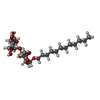


| #36: 糖 | | #39: 糖 | |
|---|
-非ポリマー , 11種, 352分子 



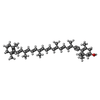



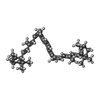

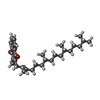










| #27: 化合物 | ChemComp-CLA / #28: 化合物 | ChemComp-KC2 / #29: 化合物 | ChemComp-II0 / ( #30: 化合物 | #31: 化合物 | ChemComp-IHT / ( #32: 化合物 | ChemComp-LMG / #33: 化合物 | ChemComp-LHG / #34: 化合物 | #35: 化合物 | ChemComp-8CT / ( #37: 化合物 | #38: 化合物 | |
|---|
-詳細
| 研究の焦点であるリガンドがあるか | Y |
|---|---|
| Has protein modification | Y |
-実験情報
-実験
| 実験 | 手法: 電子顕微鏡法 |
|---|---|
| EM実験 | 試料の集合状態: PARTICLE / 3次元再構成法: 単粒子再構成法 |
- 試料調製
試料調製
| 構成要素 | 名称: photosystem I of cryptophyte / タイプ: COMPLEX / Entity ID: #1-#26 / 由来: NATURAL |
|---|---|
| 分子量 | 実験値: NO |
| 由来(天然) | 生物種:  Chroomonas placoidea (真核生物) Chroomonas placoidea (真核生物) |
| 緩衝液 | pH: 6.5 |
| 試料 | 包埋: NO / シャドウイング: NO / 染色: NO / 凍結: YES |
| 急速凍結 | 凍結剤: ETHANE |
- 電子顕微鏡撮影
電子顕微鏡撮影
| 実験機器 |  モデル: Titan Krios / 画像提供: FEI Company |
|---|---|
| 顕微鏡 | モデル: FEI TITAN KRIOS |
| 電子銃 | 電子線源:  FIELD EMISSION GUN / 加速電圧: 300 kV / 照射モード: SPOT SCAN FIELD EMISSION GUN / 加速電圧: 300 kV / 照射モード: SPOT SCAN |
| 電子レンズ | モード: BRIGHT FIELD / 最大 デフォーカス(公称値): 1800 nm / 最小 デフォーカス(公称値): 1000 nm |
| 撮影 | 電子線照射量: 50 e/Å2 フィルム・検出器のモデル: GATAN K3 BIOQUANTUM (6k x 4k) |
- 解析
解析
| CTF補正 | タイプ: PHASE FLIPPING AND AMPLITUDE CORRECTION |
|---|---|
| 3次元再構成 | 解像度: 2.71 Å / 解像度の算出法: FSC 0.143 CUT-OFF / 粒子像の数: 118810 / 対称性のタイプ: POINT |
 ムービー
ムービー コントローラー
コントローラー




 PDBj
PDBj






















